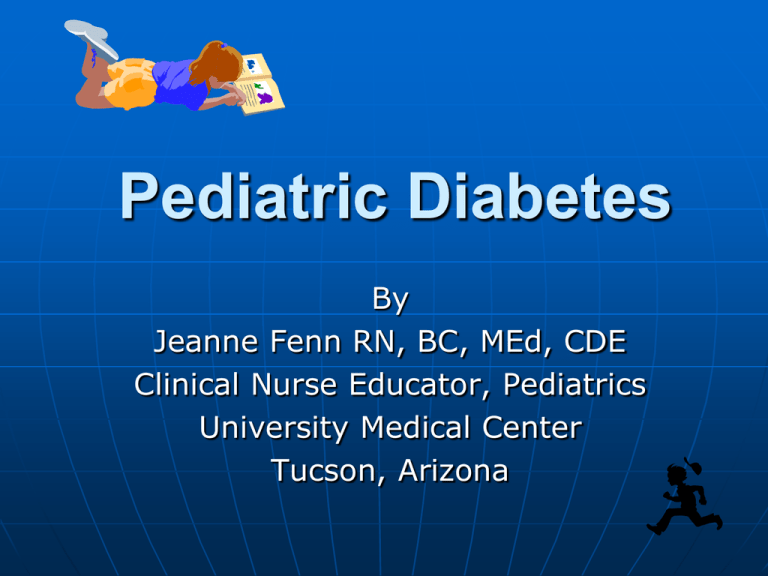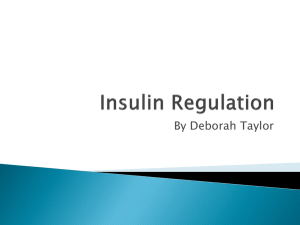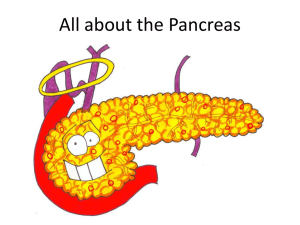
Pediatric Diabetes
By
Jeanne Fenn RN, BC, MEd, CDE
Clinical Nurse Educator, Pediatrics
University Medical Center
Tucson, Arizona
Objectives
Discuss diagnosis of of type 1 and type 2
diabetes, and cystic fibrosis-related
diabetes (CFRD).
Identify current management issues in
dealing with diabetes.
Discuss responsibilities of multidisciplinary
staff in providing basic diabetes education
and care.
Definition
Diabetes Mellitus is a chronic
disorder in which the body cannot
properly use glucose. The body also
has difficulty using fats and proteins.
Diabetes affects 24 million people in
the U.S.
90 - 95% have Type 2
1/3 of these people do not know
they have diabetes
57 million people in the U.S. have
pre-diabetes
CDC, 2008
Diabetes Diagnostic Criteria
American Diabetes Association
Each test must be confirmed on a
subsequent day:
• Symptoms plus a random plasma
glucose > 200 mg/dL
• Fasting plasma glucose >126 mg/dL
• Two-hour plasma glucose > 200 mg/dL
during an oral glucose tolerance test
Diagnosis of pre-diabetes
Impaired fasting glucose:
• FPG 100 – 125 mg/dl
Impaired glucose tolerance:
• 2-hour plasma glucose 140 – 200 mg/dl
after the OGTT
Types of Diabetes
Type 1
Type 2
Cystic Fibrosis Related Diabetes
(CFRD)
Gestational Diabetes Mellitus (GDM)
Others; steroid induced
hyperglycemia
Diabetes Management
Oral Hypoglycemics/Insulin Therapy:
• Insulin Injections
• Blood glucose monitoring
Nutritional guidelines
Prevention of:
• Hypoglycemia
• Hyperglycemia
Stress/sick day management
• Urine ketone testing
Care of the patient with diabetes
Does the pt/family(p/f) understand
the reason for the diabetes care
plan?
Can the p/f perform all the self care
skills?
Have appropriate f/u and
supplies been provided?
Psycho-social Issues
Feelings of shock, denial, and
sadness are common reactions for
people who learn they have diabetes.
Ongoing support necessary in
dealing with a chronic care issue.
Type 1 Diabetes
Autoimmune destruction of the beta
cells of the pancreas
Insulin deficiency
Insulin is necessary for survival
Diabetic Ketoacidosis (DKA)
Usually an acute onset
Type 1 Diabetes Therapy
Insulin
Type 2 Diabetes
Insulin resistance
• Subnormal response to a given
concentration of insulin
Inadequate insulin response
Increased hepatic glucose
Type 2 Diabetes
The rise in incidence of type 2
diabetes is commensurate with the
increase in obesity.
Characteristics:
• obesity
• ethnicity
• acanthosis nigricans (insulin resistance)
• family history of type 2 diabetes
Factors Related to the Onset of
Obesity
Altered dietary intake
Decreased physical activity
Increased inactivity
Altered dietary intake
Nutritional content
Portion size
Decreased physical activity
Not as much participation in physical
activities; walking, active
play, recess
Increased inactivity
Look at time spent watching
TV, playing electronic games
Screening for Type 2 Diabetes
in Children
Criteria:
• overweight (BMI > 85th %ile for age
and sex, weight for height > 85th
%ile, or weight > 120% of ideal for
height)
Plus any two of the following risk
factors:
Risk Factors for Type 2 Diabetes
• family history of type 2 diabetes in
first- or second-degree relative
• race/ethnicity (American Indian, AfricanAmerican, Hispanic, Asian/Pacific Islander)
• signs of insulin resistance (acanthosis
nigricans, hypertension, dyslipidemia,
polycystic ovary syndrome)
Acanthosis Nigricans
Type 2 Diabetes Therapy
Weight loss
Exercise
Oral agents
• Biguanides
Metformin, FDA approved for use in children
• Insulin Secretagogues
• Alpha-glucosidase Inhibitors (AGI)
• Thiazolidinediones (TZD)
Insulin
N Engl J Med 346:393-403, 2002.
Cystic Fibrosis-Related Diabetes
CFRD
Becoming a common complication of
cystic fibrosis (CF)
Prevalence rates:
• 5-9 yo: 9%
• 10 -20 yo: 26%
• By age 30 yo: 50%
Peak age of onset: 18 – 24 years
(O’Riordan, et al., 2009)
Pathophysiology of CFRD
Genetics
• Those with the most severe CF
mutations develop CFRD
Pancreatic pathology
• Excess mucus; obstruction, fibrosis, and
fatty infiltration
Insulin deficiency
Insulin resistance
• Frequent infections, inflammation
Significance of CFRD
The diagnosis of CFRD has been
associated with increased risk of
morbidity and mortality related to
influence on:
• Pulmonary function
• Nutritional status
(Mohan, Miller, Burhan, Ledson, & Walshaw, 2008)
CFRD Therapy
Early identification of CFRD and
management of blood glucose with insulin
administration stabilizes lung function and
improves nutritional status.
Insulin therapy
Optimal nutrition
O’Riordan et al., 2009)
Diabetic KetoAcidosis(DKA) &
Hyperosmolar Hyperglycemic
Syndrome (HHS)
The two most serious acute
metabolic complications of
diabetes.
Mortality rate:
• DKA
• HHS
< 5%
about 15%
Diabetic Ketoacidosis
Caused by an absolute or relative
insulin deficiency and an increase in
insulin counterregulatory hormones:
catecholamines, cortisol, glucagon,
and growth hormone.
Individuals with type 1 are more at
risk.
Precipitated by illness, infection,
trauma, surgery, and stress
DKA Clinical Presenting Symptoms:
Hyperglycemia > 250 mg/dL
Ketonemia (ketone bodies in the blood)
Ketonuria
Kussmaul respirations (deep/rapid)
Metabolic Acidosis
• pH < 7.20
• Bicarbonate < 15 mEq/L
Diabetic Ketoacidosis
Dehydration
Tachycardia
Weight loss
Hypotension
Abdominal pain
Vomiting
Decreased level of consciousness
DKA
Management:
• Fluid replacement
• Insulin drip: Regular Insulin only per IV
• Monitor
glucose/electrolytes/ketones/labs
• *Rapid correction of fluids/electrolytes
may lead to development of cerebral
edema in young patients.
• Assess/treat causes of DKA
• Monitor for complications
Hyperglycemic Hyperosmolar
Nonketotic Syndrome
(HHNK)(HHS)
Characterized by a lack of ketosis,
extremely high blood glucose
levels, and increased fluid
deficiency.
Type 2 and elderly more at risk.
Similar presenting symptoms.
Treatment of HHNK
Careful fluid rehydration
Insulin therapy
Monitor labs
Treat underlying cause
Assess for complications
Insulin
Insulin is a hormone produced in
the beta cells of the Islets of
Langerhans in the pancreas.
Administration of insulin requires
frequent blood glucose monitoring
necessary to monitor insulin
therapy
Insulin Therapy
Indicated for patients with:
• Type 1 diabetes/DKA
• CFRD
• Type 2 diabetes if other therapy is
inadequate
• secondary diabetes; pancreatitis,
steroid therapy
Types of Insulin
Rapid Acting:
• Insulin lispro (Humalog) ®
• Insulin aspart (Novolog) ®
• Insulin glulisine (Apidra) ®
Short-acting:
• regular
Intermediate-acting:
• NPH
Long-acting:
• Insulin glargine (Lantus) ®
• Insulin detemir (Levemir) ®
Insulins by Relative Comparative Action Curves
Insulin Type
Onset
Peak
(hours)
Usual Effective
Duration (hours)
Usual Maximum
Duration (hours)
Aspart (Novolog) 5-10 minutes
1-3
3-5
4-6
Lispro (Humalog) <15 minutes
0.5-1.5
2-4
4-6
Glulisine (Apidra)
<15 minutes
regular
0.5-1 hour
NPH
Glargine (Lantus)
Detemir (Levemir)
2-4 hours
3 - 4 hours
Similar to apart/lispro
2-3
3-6
6-10
4-10
10-16
14-18
--
24
24
similar to glargine
Different Analogues
Different Profiles
Insulin Therapy
Dosing regimens:
• Glargine & Lispro or Aspart
(Basal/Bolus)
• Regular/NPH
• Insulin pump therapy (Lispro/Aspart)
Food intake and insulin regimen should correlate
Intensive Diabetes Management
Insulin to Carbohydrate ratio
• Unit: Grams of CHO
• Example: 1 unit : 15 grams of CHO
Correction Factor: Units of insulin
needed to correct a blood sugar
level.
• Example: 1 unit of lispro/50 mg/dl >
150 mg/dl
Insulin Administration
Syringes: short needle, mixing
insulins
Pen injectors: flexibility
Insulin Pumps; Continuous
subcutaneous insulin infusion
(CSII) devices
Blood Glucose Goals
Age
Desired Range
Before Meals
Bedtime
< 6 yo
100-180
110-200
6 - 12 yo
90 – 180
100 - 180
13 -19 yo
90 – 130
90 - 150
ADA, 2009
Goals for Diabetes
Management: Adults
Glycemic control:
FPG (preprandial) 70 - 130 mg/dl
PPG (2-h postprandial) <180 mg/dl
ADA, 2009
Blood Glucose Testing
Frequency (varies)
Issues(school, availability of
meters,alternate site testing,)
Documentation (despite monitor
memory)
Hemoglobin A1C(HbA1c)
hemoglobin protein with attached glucose
Reflects how often the blood glucose has been
>150 mg/dl over the past 3 months.
Non diabetes: 4 – 6 %
Goals: (ADA)
< 6 yo
6 - 12 yo
13-19 yo
> 19 yo
7.5-8.5 %
< 8%
< 7.5 %
< 7% (ADA)
< 6.5% (AACE)
ADA, 2009
Goals for Diabetes
Management
Blood pressure
• Systolic: <130 mm Hg
• Diastolic: <80 mm Hg
Cholesterol: Lipids
• LDL-C <100 mg/dL
• HDL-C >40 mg/dL (men)
> 50 mg/dL (women)
• Triglycerides < 150 mg/dL
Nutritional Guidelines
Eat a well-balanced diet (there is no one
ADA or diabetic diet)
Eat meals(3) and snacks at the same time
each day
Use appropriate snacks for hypoglycemia
Carbohydrates cause the greatest rise in
blood glucose; avoid concentrated sugars
Referral to diabetes nutritionist once/year
Nutritional Guidelines
Carbohydrate Counting
• 1 carbohydrate choice = 15 grams
carbohydrate
• 1 carbohydrate choice = 1 starch
exchange(15g) or 1 fruit exchange(15g)
or 1 milk exchange(15g)
Low Blood Sugar
Hypoglycemia or Insulin
Reaction
Definition: blood glucose (bg) level
of <60 mg/dl
False reaction: Symptomatic with
rapid fall in blood sugar even though
blood sugar is not low.
Causes of Hypoglycemia
Not enough food
Too much insulin
Extra exercise
Treatment of Hypoglycemia
If person is alert, cooperative and able to
swallow: Give 1/2 cup of juice or regular soda,
glucose tabs, soft candy, sugar (15 grams)
Wait 15 minutes, check bg, if still low, repeat
If person is uncooperative, but able to swallow:
Give glucose gel (may need to rub into gums)
If seizure, unconscious or cannot swallow without
choking: Provide safety, administer glucagon
Glucagon
Counterregulatory hormone to insulin
(raises blood sugar)
Indicated for severe hypoglycemia
Hyperglycemia
Blood Glucose levels > 240 mg/dl
Refer to person’s blood glucose goals
based on age.
Causes of Hyperglycemia
Too much food
Not enough insulin or
Medication
Illness
Stress
Treating Hyperglycemia
Increase fluid intake; water
Check for ketones
Extra insulin
May need to increase appropriate
insulin
Exercise Management
Check blood glucose before, during and
after exercise.
Eat before heavy exercise.
Always carry a fast acting carbohydrate
Have extra carbohydrate snacks available.
Reduce the insulin dosage.
Change the injection site.
Be sure others know.
Do not exercise if ketones are present.
Be aware of delayed hypoglycemia
Sick Day Management
Insulin Management
• Insulin therapy must always be
continued
• Provide usual doses if eating
• Provide extra short acting
insulin(regular/humalog) if glucose is
>300 or > trace ketones.
• Estimate 10% - 15% of total daily
insulin dose for regular/humalog insulin
dose
Refer to Emergency Care
Vomiting
Unable to eat or drink.
Illness with mod/large ketones
Symptoms of DKA
Long Term Complications of
Diabetes
http://www.nlm.nih.gov/medlineplus
/ency/article/001214.htm
Long Term Complications of
Diabetes
Macrovascular
• Heart and blood vessels:
High cholesterol
Hypertension
Atherosclerosis
Microvascular
• Retinopathy
• Nephropathy
• Neuropathy
ADA Recommendations for
ongoing care:
Exercise daily 30 – 60 minutes (mod)
Thyroid Function monitored every 1 – 2
yrs
Microalbuminuria annual screening at age
10 yo or 5 years after dx.
Blood pressure every visit, treat if
elevated
Fasting lipid profiles: family history
Opthalmic annual exam at 10 yo or 3 – 5
years after dx.
ADA Recommendations:
Foot exams annually begin at
puberty
Psychosocial function/family coping
routinely.
Depression screening annually at 10
yo
ADA, 2009
Summary of Diabetes Care
Does the person/family:
• Know rationale for diabetes care
• Have appropriate supplies and
know how to use
• Know when to call for help
• Have follow-up care
Resources
www.diabetes.org
www.childrenwithdiabetes.com
www.jdfcure.org
www.cdc.gov
http://care.diabetesjournals.org/
www.barbaradaviscenter.org
• “Understanding Diabetes”
Questions?
Contact information:
Jeanne Fenn RN, BC, MEd, CDE
University Medical Center
Tucson, AZ 85274
520.694.2475
jfenn@umcaz.edu
References
American Association of Clinical Endocrinologists (2007). AACE Diabetes Mellitus Guidelines,
Diabetes Management in the Hospital Setting, Endocrine Practice, 13, Suppl 1, 59-61.
American Diabetes Association (2009). “Standards of Medical Care in Diabetes-2009”, Clinical
Practice Recommendations, Diabetes Care, 32, Suppl1, S12-49.
Center for Disease Control (2008). Number of people with diabetes increases to 24 million.
Accessed 9/26/08 at http://www.cdc.gov/media/pressrel/2008/r080624.htm
Chase, P. (2006) Understanding Diabetes: A handbook for people who are living with diabetes,
11th edition, Children’s Diabetes Foundation at Denver.
Chirico, M., Cherian, S., Anderson, S., Taylor, J. (2007). New Agents for the Treatment of
Diabetes, Review of Endocrinology, 1, 42-46.
Clement, S., et al (2004). Management of Diabetes and Hyperglycemia in Hospitals. Diabetes
Care, 27. 553-591.
References
DeLuca, M. (2007). PDR Concise Prescribing Guide, 1 Thomson Healthcare.
Gates, G. Onufer, C., Setter, S. (2006). Your Complete Type 2 Meds Reference
Guide, Diabetes Health.
McCance, K., Huether, S.(2006). Pathophysiology the Biologic Basis for Disease in
Adults and Children, 5th edition, Elsevier Mosby.
Mohand, K., Miller, H., Burhan, H., Ledson, M. J., & Walshaw, M. J. (2008).
Management of cystic fibrosis related diabetes: a survey of UK cystic fibrosis
centers. Pediatric Pulmonology, 43, 642-647.
O’Riordan, S. M., Robinson, P. D., donaghue, K. C., & Moran, A. (2009). ISPAD
clinical practice consensus guidelines 2009 management of cystic fibrosisrelated diabetes in children and adolescents. Pediatric Diabetes, 10 (Suppl. 12),
43-50.









